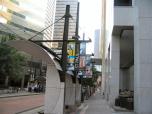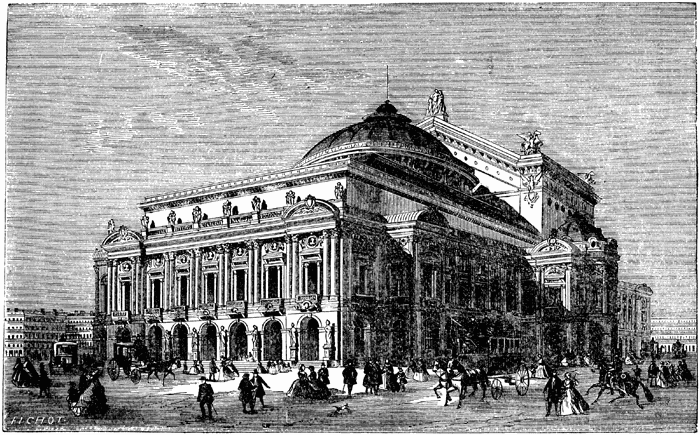




My wife and I are constantly on the look-out for new experiences and venues that we can visit or participate in that enrich our lives. One thing we appreciate is the viewing of fine art. We frequently make the rounds in North Texas between exhibits at the Dallas Museum of Art where we have a membership, the Meadows Museum at SMU, The Kimbell Art Museum, the Amon Carter Museum and the Sid Richardson Museum, the last three located in Fort Worth. With a desire however to branch out beyond these mainstays of culture, we have begun searching out galleries in the area that cater to our tastes, while at the same time exposing us to other artists. One of these galleries that we visited a few weeks ago was the Beaux Arts Gallery in Dallas’ Design district. As we had walked across the new Margaret Hunt Hill bridge during the festivities in early March, we thought we would sample some of the offerings in the district.
When one enters Beaux Arts Gallery, one is struck by the wall coverage of fine classic gallery edition prints that are recreations of rare and beautiful old prints from the 16th through 20th centuries, depicting life from bygone eras. We were specifically interested in viewing a special exhibit that the gallery was displaying pertaining to the design of the Paris Opera House. Before I could work my way back into that room however, I had to thoroughly view the works that greeted me in the first few rooms. I became engrossed with bucolic paintings quite simple in their approach, but detailed in their artistry, that adorned a flat-file cabinet in the second room I entered. I honestly am really not drawn to the very simple landscape scenes that focus just upon a figure of a child or the lone horse grazing in the pasture. However, these pictures really were beautiful in their own very intimate way. I could envision them being placed in a column on a wall next to a bookcase in a study perfectly arranged from just above eye level to knee high level next to an arm chair. Later upon speaking with the owner, I found out that some antiquarian sets contain up to 300 prints.
As I continued my journey toward the famous opera house, I spent some time in the “map room”, a gallery filled with early Texas maps and decorative posters from the 1936 Texas Centennial celebration in Dallas. The posters reminded me of some I had viewed at the Bob Bullock Museum in Austin the past few years.
What is the meaning behind Beaux Arts? Beaux Arts architecture expresses the academic neoclassical architectural style taught at the École de Beaux-Arts in Paris. I was in Paris a number of years ago, but like any typical tourist, I focused on the high-lights from Notre Dame to the Louvre with icons such as the Eiffel Tower sandwiched in between. In 1998, I would not have been able to differentiate Beaux Arts from Baroque. According to wikipedia, the style "Beaux Arts" is above all the cumulative product of nearly three centuries of instruction under the authority, first, of the Académie Royale d'Architecture (1671–1793), then, following the French Revolution of the late 18th century, of the architecture section of the Académie de Beaux-Arts (1795— ). The style of instruction that produced Beaux-Arts architecture continued without major interruption until 1968.
This discussion of Beaux Arts brings me to the exhibition room where these chromolithographs and steel engravings dating to 1878 of Le Nouvel Opera de Paris were displayed. Its architect, Jean Louis Charles Garnier (1825-1898), was born on November 6, 1825, in Paris. He became the apprentice of the French architect Louis Hippolyte Lebas and learned neoclassical style design. He was a full time student at École de Beaux-Arts in 1841. Garnier spent 5 years in Italy after winning the Grand Prix de Rome in 1848 at the age of 23. He later traveled through Greece and found architectural inspiration among the ruins there. Garnier entered the design competition for the Académie Nationale de Musique, better known as the Opéra, in Paris in 1861. He won fifth prize in the first stage of a two-phase competition and later that year won the commission selected from over 171 entries. The Opéra was built from 1862 to 1867; the interiors were not completed until 1874. The folio Le Nouvel Opera de Paris was published in 1878 to honor Garnier's grand design.
Beaux Arts gallery in Dallas was opened in 1988 with reproduction prints that were primarily architectural prints. The gallery still has quite a number of them from their original collection. The owner, a Dallas native who was attracted to the decorative, saw this as an attractive business opportunity. Once he got deeper into it, and recognized the beauty in these prints, he got religious about his work. At the beginning, the gallery’s collection primarily consisted of architectural prints but as time progressed, antiquarian prints comprised the majority of its collection. The prints on their walls all use paper that is handmade of cotton. Tree pulp paper did not begin being used on prints until the late 19th century.
The owner had spent some time allied with the printing industry and was interested in how things were produced. He became an expert in how these prints were made and then fell in love with the beauty and history of them. He was enlightened to the 500 years of science, history and discovery in these works, of which he knew little when he started the gallery in 1988. The education process took him many years. Since there is no formal program in print history, to become an expert, one must be self taught.
Framing became very important to Beaux Arts as most frame shops did not know how to frame these prints. His passion as the business progressed pushed him to higher and higher quality. The gallery has a motto: “We are expensive, but slow”. Their prints now reside in the Australian Embassy in Beijing, St. Petersburg, Russia, Spain, Argentina, the Caribean, and other places. However, the bread and butter of their business is catering to the 6.5 million persons who reside in North Central Texas. Their business is very vertically integrated from finding the work to restoration and framing, to selling and curating, to writing about it, publishing and reproduction. Together with a few other galleries in New York, Chicago, Atlanta, Boston and Houston, Beaux Arts Gallery is fairly unique.
If you are considering some additional pictures to hang on your living room wall, or simply interested in discovering a new art gallery to visit, come to Beaux Art and view five hundred years of history in living color.
Walls in Living Color
Posted April 1, 2012 by Chuck DeShazo
